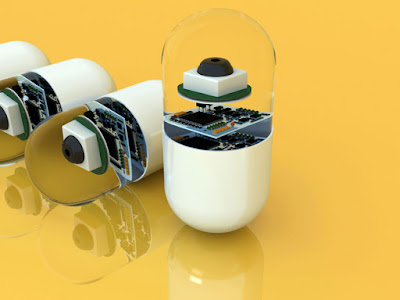Nanotechnology in medical wearables and implants is revolutionizing the way medical conditions are monitored, diagnosed and treated
Imagine contact lenses which proactively monitor the blood glucose levels of your tears and transfer that information to a doctor’s mobile device, or an intelligent management system for asthma, lower back issues or a smart health patch which keeps tabs on a patient’s vitals? Some of these devices are being developed, while some are already in use.
A market set to boom
Nanotechnology involves manipulating materials on an atomic or molecular scale, especially to build microscopic devices, such as medical wearables, which can be worn on or in the body. The diverse parts comprising this technology include microchips, biosensors, special coatings for tiny devices and very small scale batteries. Medical wearables are increasingly smart. Gathered information can be conveyed for external analysis. The aim is to provide patients with tailored treatments if required.
A report by research company MarketsandMarkets entitled Nanotechnology in Medical Devices Market shows great potential. It states that the global nanotechnology for medical devices was valued at around USD 5 billion in 2014 and is expected to reach USD 8,5 billion by 2019.
Like any new industry, and even more so for health-related products, manufacturers of such wearables will need to ensure users that their products are safe, reliable and function correctly. The work of a number of IEC Technical Committees (TCs) contributes to achieving this, while enabling the industry to evolve and innovate.
Standards for better well-being
The safety of patients using medical devices (internal/external wearables) is paramount, whether the devices are powered by battery or the mains. Several IEC TCs prepare International Standards for the different parts that make up these devices. IEC TC 62: Electrical equipment in medical practice, covers electrical equipment, electrical systems and software used in healthcare and their effects on patients, operators, other persons and the environment.
IEC TC 113: Nanotechnology standardization for electrical and electronic products and systems, comprises the terminology, measurement and characterization and performance assessment of substances, such as luminescent nanoparticles, used for diagnosing diseases or certain coatings for implanted devices, as well as new materials for nano-enabled batteries.
It is currently working on specific tests for graphene, a highly versatile substance, which could eventually be used for a wide variety of applications, including electronics thanks to its remarkable properties. In the case of medical wearables, it could be used for thin, flexible electrodes. The TC is drawing on its global expertise to find out how to measure conductivity, for example, between two electrodes on a graphene layer.
Graphene is the thinnest, strongest and lightest compound known. At one atom thick (a million times thinner than a human hair), it is between 100 to 300 times stronger than steel. With one square meter coming in at around 0,77 milligrams it is ultralight while remaining very flexible. It is also a highly electrically and thermally conductive transparent conductor. Its potential is so great that Europe’s largest ever research initiative, the Graphene Flagship Project, is dedicated to developing its use in many areas.
Wafer thin printed electronics and nano batteries
Printed electronics or the printing of circuits on rigid or flexible substrates is often merged with 3D printing and provides interesting options for medical applications. These include wearable sensors and monitors, for example, skin patches or implantable glove-like cardiac monitoring devices fitted with tiny printed sensors. While IEC TC 62 creates Standards for electrical equipment in medical practice, IEC TC 119: Printed electronics, produces Standards for the printed electronics parts, some of which are used in such equipment. The Standards cover their terminology, materials, processes, equipment, products and health/safety/environment aspects.
As battery technology evolves to very small scale for these devices, the work of IEC TC 21: Secondary cells and batteries, will ensure safety installation principles, performance, battery system aspects, dimensions and labelling for existing and new developments through the Standards it produces.
For more information on IEC TCs which contribute to medical wearable technology, including audio video and multimedia systems, electromagnetic compatibility, methods of assessment for magnetic and electromagnetic fields associated with human exposure, safety of electronic equipment in these fields, environmental aspects and more, see the article Printed Electronics in the January/February 2016 issue of e-tech.
The benefits are many
Constant minimally-invasive health monitoring already improves the quality of life for many people living with serious health conditions. It can also flag up potential illnesses and help prevent diseases developing. This kind of monitoring saves time and costs thanks to fewer physical appointments, and can provide more targeted, effective solutions. The scope of application for this kind of healthcare is broad, for example, for people located far from their doctors, those with busy schedules, or aging populations, who may be less mobile. Some hospitals in the US have already begun adopting software systems to track the medical histories of consenting patients. It also provides doctors with a bigger picture of a patient’s health, as opposed to a snapshot during a single visit.
Staying securely connected
There is no doubt that the technology behind medical wearables is disrupting the health industry and how it diagnoses and treats health conditions. Increasingly more personal data is gathered, conveyed and stored in individual devices and larger healthcare systems. Despite the benefits, there are still important issues which must be solved before it is broadly adopted.
As the medical industry creates more smart solutions to health issues, more personal data will need to be conveyed and stored securely for analysis. As already experienced with smart phones, smart homes and connected cars, any devices connecting to the Internet of Things, must provide the protection of personal data. This is even more critical in the case of devices such as pacemakers or drug delivery systems.
The IEC has set up a number of technical committees, which are working towards ensuring this. Data security, integrity and privacy are central to the work of IEC TC 62. In particular, IEC Subcommittee (SC) 62A: Common aspects of electrical equipment used in medical practice, has prepared International Standards and Technical Reports that cover medical device software and IT networks incorporating medical devices.
In general, International Standards for IT security techniques are covered by ISO/IEC JTC 1/SC 27, a SC of the Joint Technical Committee (JTC) set up by the IEC and the International Organization for Standardization (ISO) to work on International Standards for information technology, which contribute significantly to data security in the medical world.
Additionally, the IEC Advisory Committee on Security (ACSEC) deals with information security and data privacy matters which are not specific to a single IEC TC; coordinating activities related to information security and data privacy; providing guidance to TC/SCs for implementation of information security and data privacy in a general perspective and for specific sectors.
Cybersecurity is also the focus of the IEC Conformity Assessment Board (CAB) Working Group (WG) 17, and IECEE Policy and Strategy (PSC) WG.
Support of Agency





Comments